Keeping a plump customer base is a unified goal for all business areas. In this endeavor, customer retention remains the most feasible blueprint, rooted in providing exceptional customer experience (CX) in all stages of the sales process. Uncover what it means to retain customers, metrics and strategies you can implement, expert tips, and the latest trends.
What Is Customer Retention?
Customer retention is a collective approach to turning first-time customers into repeat buyers, driving sustainable brand loyalty. It involves a set of strategies and specific actions designed to reduce customer churn and encourage continuous patronage that offshoots into word-of-mouth recommendations.
Evidently, customer retention or customer nurturing is a significant part of the post-sales phase. Effective strategies often involve sales, marketing, and customer service, joining forces to execute positive CXs.
Retention vs Acquisition
While customer retention concentrates on converting previous buyers into permanent customers to build cyclical profits, customer acquisition attracts new customers for fresh revenue. One strategy does not go above the other, particularly for established businesses. Instead, both customer acquisition and retention are implemented simultaneously to sustain a growing customer base.
Small businesses and startups tend to focus more on customer acquisition during the initial phase of their launch. Expected as this may be, postponing customer acquisition after a certain period of time is a rookie mistake.
As early as the planning timeline, acquisition efforts should already tie up directly with retention strategies, such as launching a loyalty program. In fact, 83% of consumers globally said a loyalty program influences their repeat purchase decisions.
Importance of Customer Retention
Retaining customers can increase your business value in multiple ways. With your existing customer base, you not only generate regular revenue but also drive significant referrals through a solid loyalty and referral program. Increased profitability is merely the overview of the impact of customer retention. The following is an outline of its particular benefits for your business growth.
- It allows you to save costs as it is less expensive than acquisition.
- It promotes repeat purchases and increases the customer’s lifetime value.
- It increases trust, loyalty, and satisfaction among customers.
- Long-term customers can provide valuable feedback and information on preferences and pain points that can be used to improve products and services.
- Sustainable client retention efforts will give you a stronger market position.
Small businesses that improve customer retention can expect to thrive for a long time, especially with customer-centric strategies. But before implementing such tactics, it’s crucial to study your existing customers by building customer profiles and creating customer personas. In addition, each tactic has to be evaluated after a specific period based on relevant metrics.
Customer Retention Metrics
Measuring customer retention requires quantitative and qualitative methods to accurately determine profitability, predict repeat purchases, and pulse customer satisfaction. The data from these evaluations should provide valuable insights that dictate improvements in your future actions. Consider including the following metrics when assessing your customer retention strategies:
This metric measures the percentage of customers retained or converted into repeat buyers over a period of time. Customer retention rate is the primary gauge for assessing campaigns and efforts to nurture existing customers and build loyalty.
To calculate your CRR, you’ll need to set a particular time frame first. It could be within a quarter, a year, or a more customized period. Simply subtract the number of new customers gained throughout the period (N) from the total number of customers when the period closed (E). Divide the figure by the number of customers at the start of the period (S).
CRR = [(E-N) / S] × 100
- E: The number of customers at the end of the period
- N: The number of new customers gained during the period
- S: The number of customers at the start of the period
The existing customer growth rate focuses on revenue growth. Particularly, it measures the profit generated from existing customers over a period of time. Much like CRR, you have to identify a specific time to measure the revenue growth rate from the present customer base.
Existing Customer Growth Rate = [(R2-R1) / R1] × 100
- R1: Revenue from current customers at the start of the period
- R2: Revenue from current customers at the end of the period
Also known as repeat customer rate, this metric measures the percentage of customers who made over one purchase within a particular time. A repeat purchase may indicate a sustainable interest in your products or services, a positive customer journey, and the overall strength of your customer retention strategies—making it one of the most valuable sales metrics.
Calculating RPR is as simple as dividing the number of repeat customers within a certain period by the total number of customers. Multiply the quotient by 100, and you have your RPR.
| RPR | = | Number of Repeat Customers | × | 100 | |
| Total Number of Customers | |||||
The churn rate measures the percentage of customers who have terminated their relationship with the business as buyers, subscribers, or clients. This metric is also known as the attrition rate or customer churn.
An increased churn rate often signals critical issues in customer satisfaction, product or service quality, pricing, etc. As a result, your business will decrease profits, which, in turn, can incur additional customer acquisition costs.
To generate your churn rate, divide the number of churned customers by the total number of customers within a given period, then multiply the result by 100. Use our calculator below to derive your churn rate instantly.
| Churn Rate (%) | = | Total Number of Customers Lost During Time Period | × | 100 | |
| Total Number of Customers at the Start of Time Period | |||||
This metric measures the amount of revenue you lose because of customer churn. Many businesses, particularly software-as-a-service (SaaS) companies selling subscriptions with cancel-anytime or downgrade options, calculate revenue churn monthly to get their monthly recurring revenue (MRR). Follow the formula to calculate revenue churn.
Revenue Churn (%) = [(SMRR – LMRR) / SMRR] × 100
- LMRR: Lost MRR at the end of the month
- SMRR: Recurring revenue at the beginning of the month
Customer lifetime value, or CLV, projects the net profit that can be generated from a customer throughout their relationship with your business. CLV covers a customer’s initial purchase and future purchases to determine their overall value. Follow the formula to calculate CLV.
The net promoter score (NPS) is a metric that evaluates customer loyalty and satisfaction. It is based on a survey in which customers are asked to rate the likelihood of them recommending your products or services, or your business in general, to others in their circle.
The NPS is based on a scale of 0 to 10. Results from this evaluation can provide you with insights into the potential referrals you can get from existing customers.
The NPS is calculated by subtracting the percentage of detractors from the percentage of the promoters. A higher score entails favorable customer loyalty and satisfaction.
Another tool that gauges how your customers feel about your products and services is the customer satisfaction (CSAT) score, in which customers will rate their satisfaction typically on a scale of one to five. CSAT is a common sales metric that serves as a yardstick for business growth, competitive advantage, and customer service performance.
Measuring CSAT involves providing a brief survey sent immediately after a customer transaction, such as a customer service call or purchase, or as part of your long-term relationship assessment with established clients. A higher CSAT result indicates a high level of satisfaction, while a low CSAT demands strategic changes that should immediately address particular pitfalls in sales and customer service.
While these customer retention metrics provide valuable insights on how you can strategize your business growth, know that the execution of these tools may take time, effort, and careful planning. Which metrics you should include in your evaluation will depend on your business goals, customer base, and industry standards.
Analyze and present metrics from your customer relationship management (CRM) software. When it comes to data visualization, you can never go wrong with Pipedrive. Access various sales dashboards with custom reports that underscore your wins and areas for improvement.
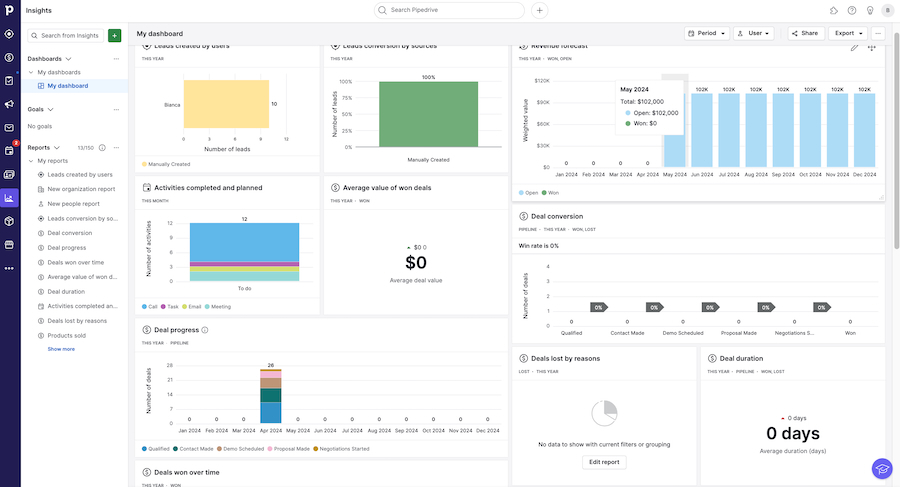
A Pipedrive dashboard with lead, revenue activity, and deal reports (Source: Pipedrive)
Customer Retention Examples & Strategies
A robust customer retention program includes various tactics designed to create a positive customer journey—from the first point of interaction with your business and initial purchase to every customer service transaction and renewal or repurchase.
If you want a unique approach, you can always think outside the box. But you can also take inspiration from these customer retention examples that have withstood the test of time.
1. Maintain excellent customer service
Your customer service (CS) system plays a significant role in leaving a favorable impression on customers as the CS team interacts with the base at times when emotions are high. Simply put, how you deal with queries, frustration, anger, and fear can leave a mark on your customer service experience.
Make it a mission to form the best customer service practices in your business, such as reducing response time, using multiple CS channels, keeping a light but helpful tone, and providing a personalized approach. Uncover other expert tips from real-life customer service examples.
2. Build a customer loyalty program
Everyone loves rewards and discounts. In many cases, they are enough to capture customer interest and, best of all, loyalty. A well-thought-out loyalty program encourages repeat purchases and referrals, which begins by understanding your customers and setting clear goals.
Some of the most engaging loyalty rewards systems include point-based programs with discounts, gifts, and unique products given to customers who earn points or perform specific actions, exclusive membership, and tiered rewards. Naturally, the best type of loyalty rewards program is based on your target audience and their buying behavior, the industry you’re in, and your budget.
Expedite results through built-in apps and strategy-enhancing features in your customer retention and CRM software. For example, Bitrix24 offers a bevy of ecommerce tools designed to build loyalty, such as automated email marketing and deal management.
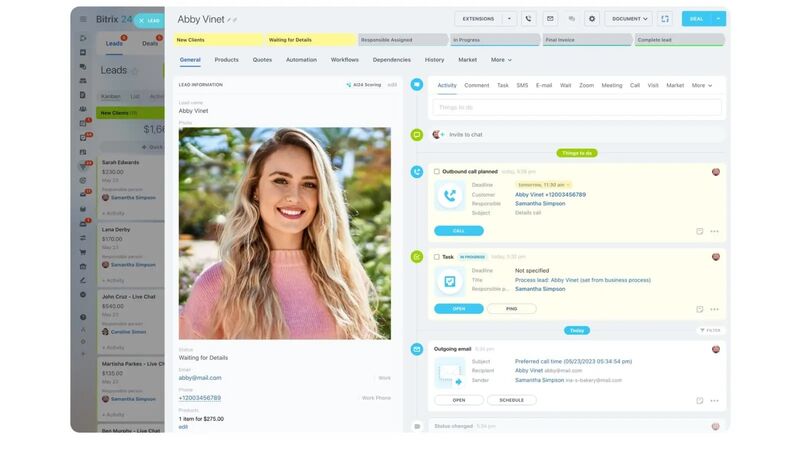
Bitrix24 offers tools to streamline email marketing for loyalty building. (Source: Bitrix24)
3. Ensure a personalized experience
Customer retention isn’t a one-size-fits-all approach. In fact, the very core of retention programs is personalization, wherein the customer journey is designed based on customer preference, budget, purchase history, and other factors.
Incorporate personalization strategies into your sales and customer service practices, such as offering personalized product recommendations and promotions based on your customers’ previous purchases or browsing histories. Plus, customize your marketing messages and overall communication tone.
4. Maximize customer communication
Proactive communication can ensure your business remains relevant and unforgettable, especially among your existing customer base. Consider sending email newsletters with discounts and promotions, product recommendations for upselling and cross-selling, and seasonal rewards.
In addition, use various channels to boost customer engagement via regular interactions and expand brand awareness by discussing industry trends. Show your care by sending renewal reminders, birthday greetings, and new product announcements.
Streamline customer communication using a CRM solution. HubSpot CRM, for example, automates email sends based on events and triggers. Easily schedule follow-ups, set meetings, and even generate email content.
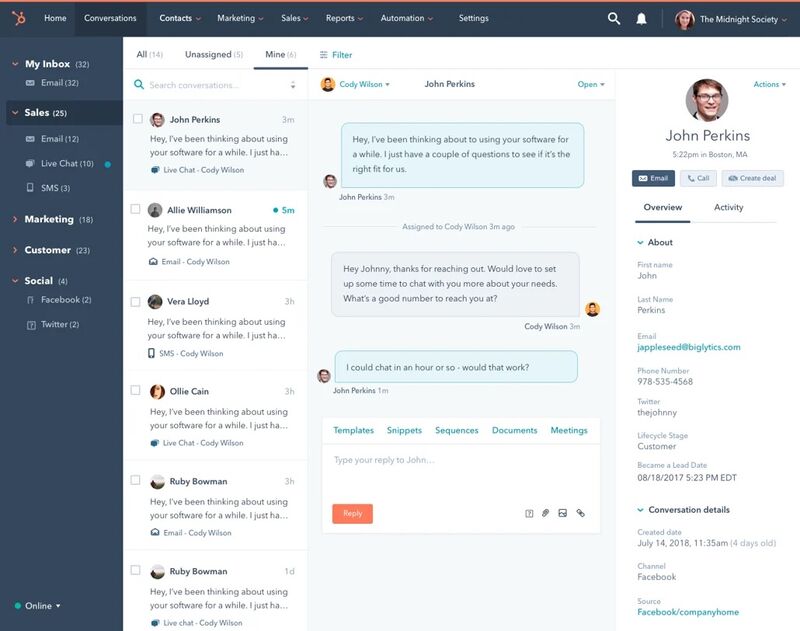
Initiate conversations with customers straight from the HubSpot CRM. (Source: HubSpot)
5. Invest in self-service tools
Customers always appreciate having the ability to get hold of answers, solve problems on their own, and expedite certain processes without going through a hundred and one steps. This is why self-service tools are crucial for client retention.
Make sure to provide a knowledge base, FAQs pages, interactive tutorials, videos, chatbots, virtual assistants, and support widgets on your website. If you’re in SaaS, a self-service portal is practically non-negotiable, as it helps customers access and manage their accounts.
6. Collect feedback from customers
Understanding customer behavior and preferences is key to customizing their interactions with your business. Gather customer feedback using surveys, forms, emails, social media, and interviews.
Set up a review collection page on your website and monitor those posted on third-party platforms. Regardless of whether the review is positive or negative, collect them as they are to understand both ends of customer sentiments. Then, respond to customer feedback appropriately.
7. Schedule customer education efforts
Exclusive events like webinars, conferences, expos, and trade fairs are perks that are highly valuable to customers who want to network and learn more about industry trends. They also boost your authority and status as a business leader. You can also provide courses or set up a podcast that addresses common customer concerns or queries.
Send an annual or biannual customer happiness survey with a customer service platform like Zoho Desk. Its analytics feature can help you track customer feedback and automate responses based on every interaction.
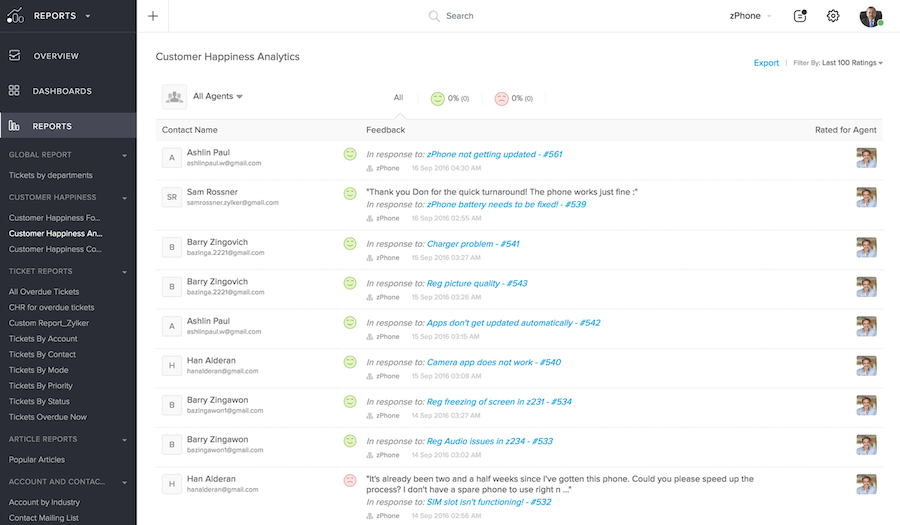
Zoho Desk customer happiness analytics (Source: Zoho Desk)
Expert Customer Retention Tips
Planning and executing your customer retention strategies have to be smooth and systematized. Otherwise, you risk setting back your efforts. On the flip side, a well-implemented tactic can further maximize the benefits of customer retention. Follow these expert tips to ensure you actualize your strategies in the right direction.
1. Focus on CX
Customer retention means ensuring convenience, transparency, efficiency, and the feeling of being valued. Carefully address these and other needs when establishing your client retention program.
For example, with referral systems, make sure the mechanics of the perks are clear and the actual claim is easily processed. Loyal customers should be spared from figuring out how the reward system works.
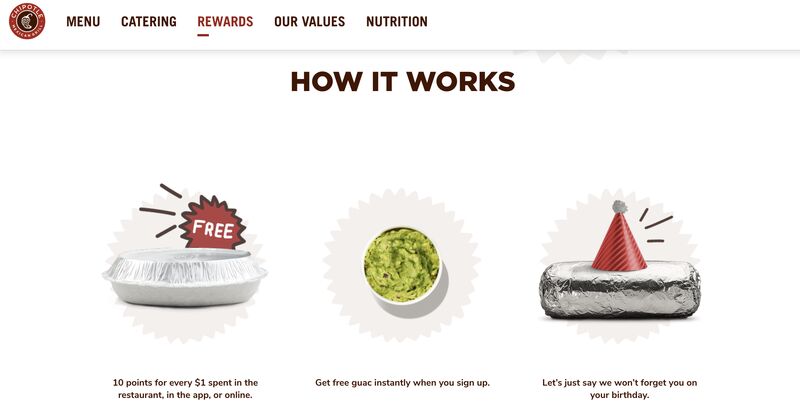
Chipotle’s rewards page offers clear and concise ways to claim rewards. (Source: Chipotle)
2. Empower your employees
A customer-centric culture must be agreed upon and uniformly implemented across departments. It shouldn’t be exclusive to customer-facing teams. Instead, make it a part of your employee onboarding and training to align all team members, regardless of role, with your mindset and values.
3. Be creative with your incentives
Customers want something new, even with rewards and loyalty incentives. While discounts and coupons always work, expanding your list of perks can further win your existing customers’ hearts and interests.
For example, if you’re in retail, consider providing a birthday discount for those who repeatedly shop in your store. On the other hand, if you’re a business-to-business (B2B) service provider, offer experiential rewards, such as VIP access to events and early access to new software features.

Annmarie offers redeemable discounts in a tiered point system. (Source: Annmarie)
4. Monitor and analyze feedback consistently
Feedback can provide a goldmine of ideas to increase customer retention, so it’s crucial to categorize and identify key insights as soon as the forms or surveys are gathered.
For qualitative feedback, look for common themes, sentiments, issues, and compliments. Qualitative data can be narrowed down by calculating average figures, giving you a sense of what customers feel or think about your products and services.
5. Leverage customer retention software
Business tools such as CRM, customer service management software, and messaging software have long included automation for customer retention campaigns, email newsletters, loyalty rewards systems, and other tactics. Maximizing their use makes implementing, optimizing, and tracking strategies easier, saving time and costs.
Which tool you should use will depend on your budget, team size, and target market. But Freshsales tops our list of the best customer retention tools for B2B sales retention.
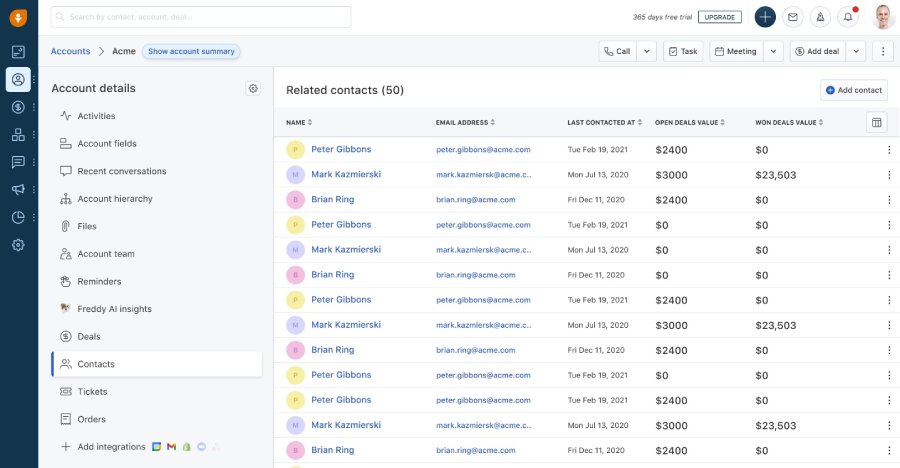
Freshsales account contacts in a single view (Source: Freshsales)
Customer Retention Statistics
While there’s no doubt that an effective customer retention strategy keeps your revenue afloat, statistical evidence of such an impact speaks to an additional volume. In addition, trends in client retention continue to favor personalized purchase experiences, as shown by percentage preference. Key statistics on customer retention can help you develop the best tactics for your business.
SaaS businesses with top-notch customer retention programs grow 1.5-3 times faster than competitors
Why that matters: Just a small percentage of customer retention improvement can result in a huge growth in your company’s return on investment (ROI). Focusing on efforts to retain customers can save money and improve your ROI since you won’t spend as many resources on customer acquisition. (Source: ChartMogul)
31% of CRM leaders say improving customer retention is a top CX goal
Why that matters: Investing in the right CRM tool can help you become better equipped to handle each stage of the customer journey. Leverage a CRM that offers AI-powered analytics, omnichannel support, self-service tools, and interaction personalization tools to prevent customer churn. (Source: HubSpot)
Relationship marketing is a driving force for customer retention, trust, and satisfaction
Why that matters: Focusing on long-term CRM goals like customer loyalty and retention can result in free word-of-mouth referrals and lead generation from your current customer base. Short-term goals like closing individual sales deals or acquiring new customers are important.
However, relationship marketing can lead to ongoing business and help your company reduce marketing spending, gain a competitive advantage, and increase customer satisfaction. (Source: SpringerOpen)
33% of consumers say it takes three purchases to establish brand loyalty, 37% say five
Why that matters: Establish a good customer loyalty program that will encourage people to make repeat purchases from your business. Doing this will not only drive your sales but will also increase brand loyalty. Leverage loyalty software that you can use to easily implement that program and train your staff to promote it to potential customers. (Source: Yotpo)
94% of customers would buy again after a positive CX
Why that matters: To create a positive CX, understand your target market’s buying behavior, ad engagement, and personal preferences. In doing so, you can create customer profiles that allow you to detail the most significant information (e.g., demographics, psychographics, behavioral) to form a data-driven customer retention strategy. (Source: Statista)
Frequently Asked Questions (FAQs)
Customer retention, when done right, can boost business performance in terms of increased profitability, improved brand reputation, customer satisfaction, and reduced marketing costs. It allows for long-term growth and sustainable success as client retention provides valuable insights into pain points, customer expectations, and preferences that breed innovation and a better business approach.
Customer experience remains the most crucial element of customer retention. However, keep in mind that CX is an all-catch term for a combination of exceptional product or service quality, customer service, strategic promotions and loyalty awards, personalization, and regular communication with existing customers.
Consider creating a sub-team from your marketing and customer service departments to focus solely on customer retention. Make it a part of your strategy to trace CXs from a specific point of engagement down your pipeline. Identify opportunities to maximize their interest as returning customers and events that might set them off. Create subsets of strategies for each scenario.
Bottom Line
Prioritizing customer retention is crucial for building a loyal customer base and driving sustainable brand loyalty. The most suitable strategy for your business can help you reap higher profitability and gain a competitive advantage. Plan your program carefully by incorporating strategies for giving loyalty rewards, using self-service tools, creating a feedback loop, and ensuring personalized CXs.